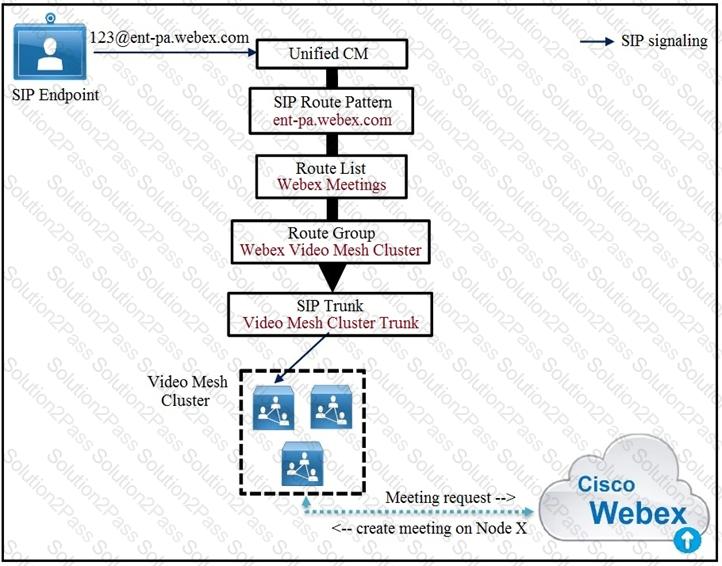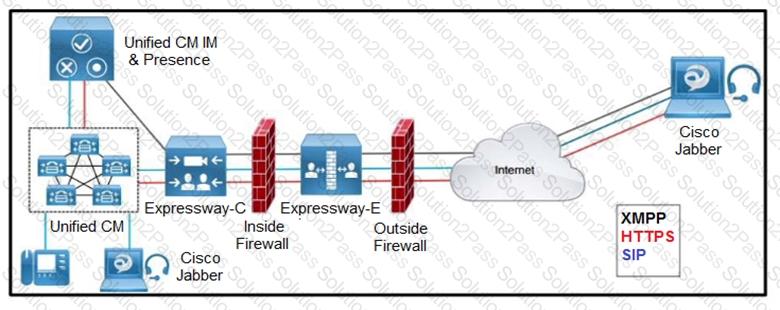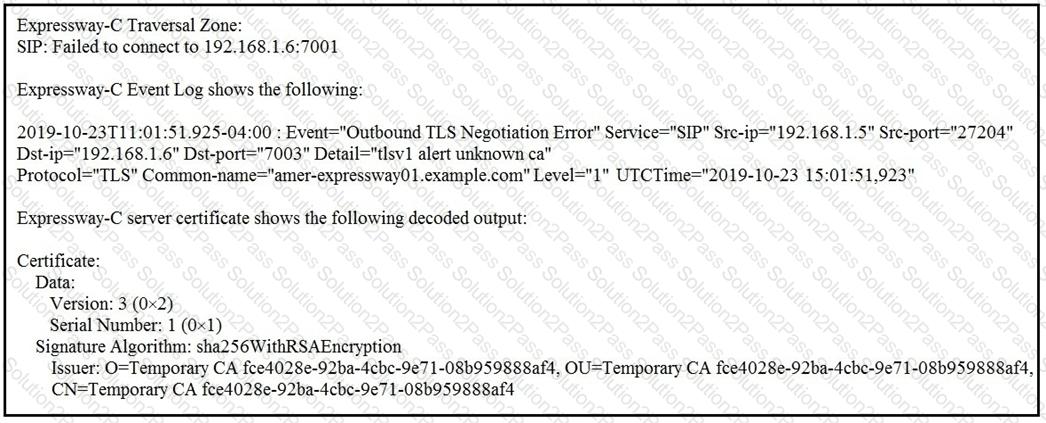300-820 Cisco Implementing Cisco Collaboration Cloud and Edge Solutions (300-820 CLCEI) Free Practice Exam Questions (2025 Updated)
Prepare effectively for your Cisco 300-820 Implementing Cisco Collaboration Cloud and Edge Solutions (300-820 CLCEI) certification with our extensive collection of free, high-quality practice questions. Each question is designed to mirror the actual exam format and objectives, complete with comprehensive answers and detailed explanations. Our materials are regularly updated for 2025, ensuring you have the most current resources to build confidence and succeed on your first attempt.
An external Jabber device cannot register. While troubleshooting this issue, the engineer discovers that privately signed certificates are being used on Expressway-C and Expressway-E What action will resolve this issue?
Refer to the exhibit.

Cisco Unified Communications Manager routes the call via the Webex Meetings route list and route group to the Video Mesh cluster Node#1 in the Video Mesh cluster is hosting the meeting and has reached full capacity, but other nodes in the cluster still have spare capacity.
What happens to the participant's call?
What is the result if force encryption for media is enabled in the Expressway on a zone that points to a system/endpoint that is not configured for encryption?
Refer to the exhibit.

Which two outbound connections should an administrator configure on the internal firewall? (Choose two.)

Refer to the exhibit. When a user tries to sign in to the Cisco Jabber client through Mobile and Remote Access, they receive this error message: “Cannot communicate with the server.” The external DNS server is configured with the SRV records listed in the exhibit.
What is the cause of the issue?
What allows endpoints behind a NAT to discover the paths through which they will pass media?
An engineer attempts to upload a server certificate to an Expressway-C server but receives an error when they click the upload button that says that the file is invalid. The engineer is advised that this happens because the certificate was signed incorrectly and is missing an attribute. What must the engineer do to upload the certificate?
A company has an on-premises Cisco collaboration cluster that contains Cisco UCM, IM and Presence, and Cisco Webex in the cloud. The company wants to integrate the on-premises infrastructure with Webex to enable interoperability with the Webex App. An engineer already configured the cluster in Cisco UCM, IM and Presence, and the organization in the Webex Control Hub. Which action must the engineer take to complete the configuration?
A Jabber user is being prompted to trust the Expressway-E certificate when using Mobile and Remote Access. The administrator has validated that the Expressway-E certificate is being trusted by the machine running the Jabber client.
What else can be done to solve this problem?

Refer to the exhibit. An administrator troubleshoots Cisco Jabber users experiencing issues when trying to log in and notices errors in the Jabber problem report log. The administrator also sees that the Intercluster Sync Agent service is not running on the IM and Presence server. Why is the Jabber client unable to sign in?
An organization with a domain name of example.com.
Which two SRV records are valid for a SIP and H.323 communication? (Choose two.)
A network engineer is configuring Mobile and Remote Access for the environment and must add the Certificate Authority into the Expressways. How does the engineer perform this action?
In a Mobile and Remote Access deployment, where must communications be encrypted with TLS?
A Webex administrator is configuring the Webex Control Hub to enable enterprise users to sign into Webex securely by authenticating to the IdP of the organization. To conform to the SAML specification, to what can the NameID format be set?
Drag and drop the required SAN field items from the left onto the features within the server categories on the right.

An administrator is deploying Cisco Expressways for Mobile and Remote Access. The registration domain is “example.com”, and the Expressway-E FQDN is “expe.example.com”. Cisco Jabber clients on the internet cannot discover services via DNS lookup. Which SRV records must be configured in the public DNS to allow Service Discovery?
Refer to the exhibit.

An Expressway-C and Expressway-E are configured for B2B calling and the Expressway- E zone is set to TLS Verify Currently, calls do not reach the Expressway-C. The Traversal Client zone on the Expressway-C for B2B reports the information in the exhibit for the Peer 1 address.
Which action resolves this error?
Which media encryption mode can be configured on an Expressway zone?
Which two internal SIP endpoints behind a firewall place calls to external devices? (Choose two.)
Which describes what could do on the Expressway-E to successfully route calls from Expressway-C on the internal network to the Internet?

